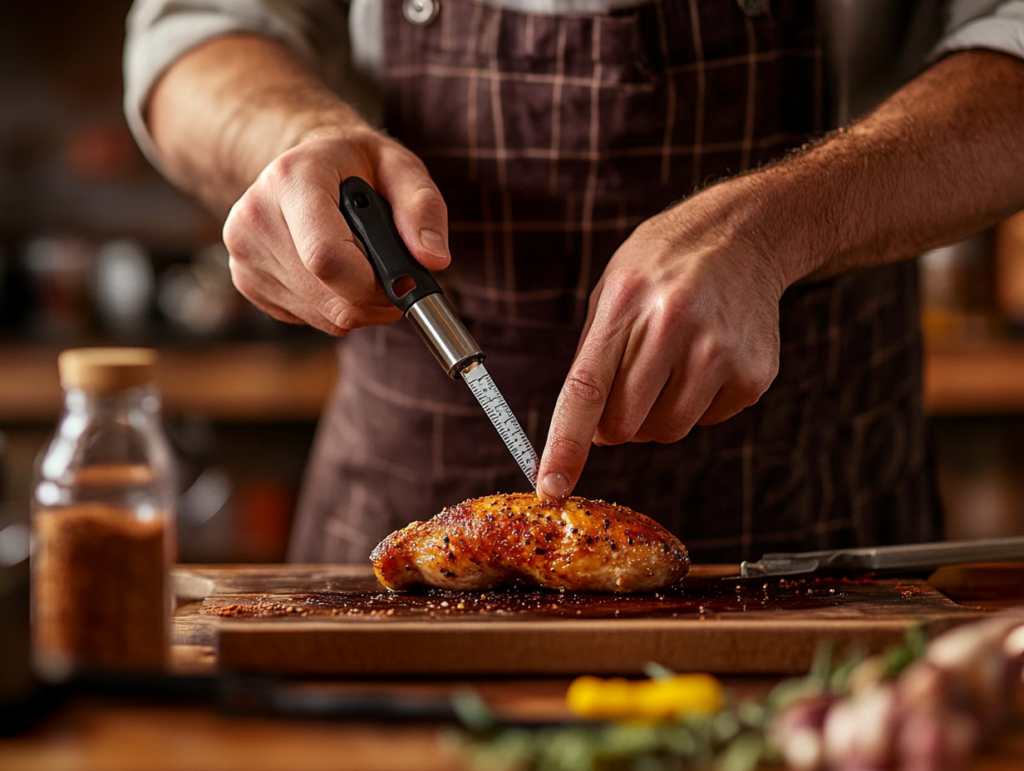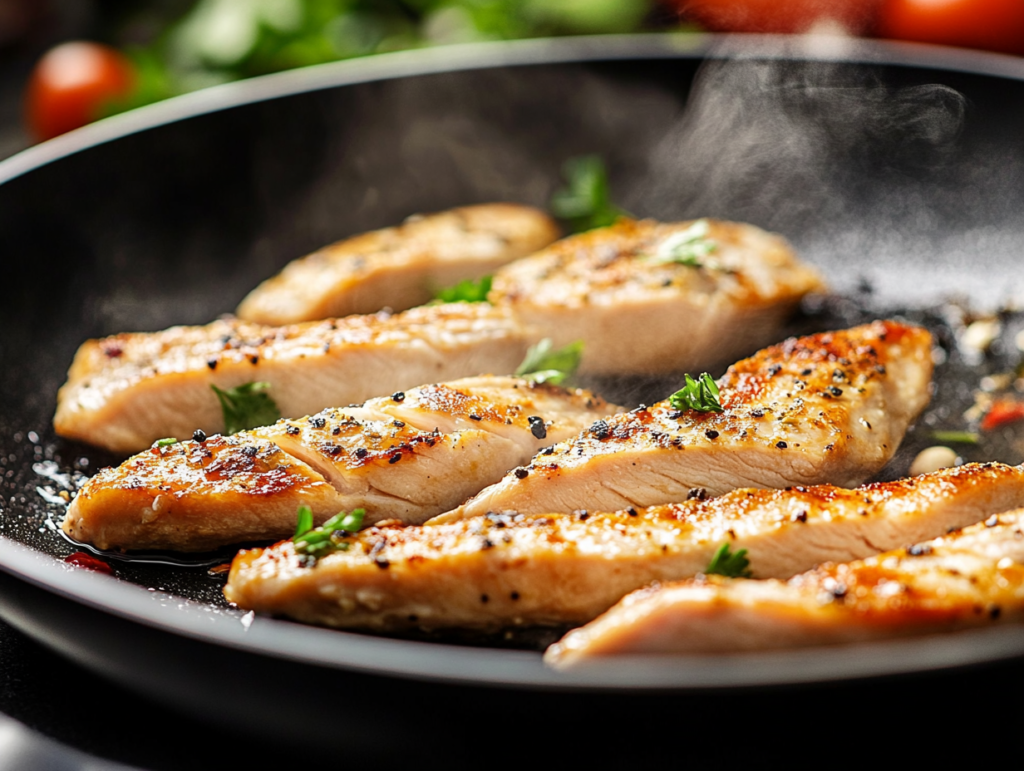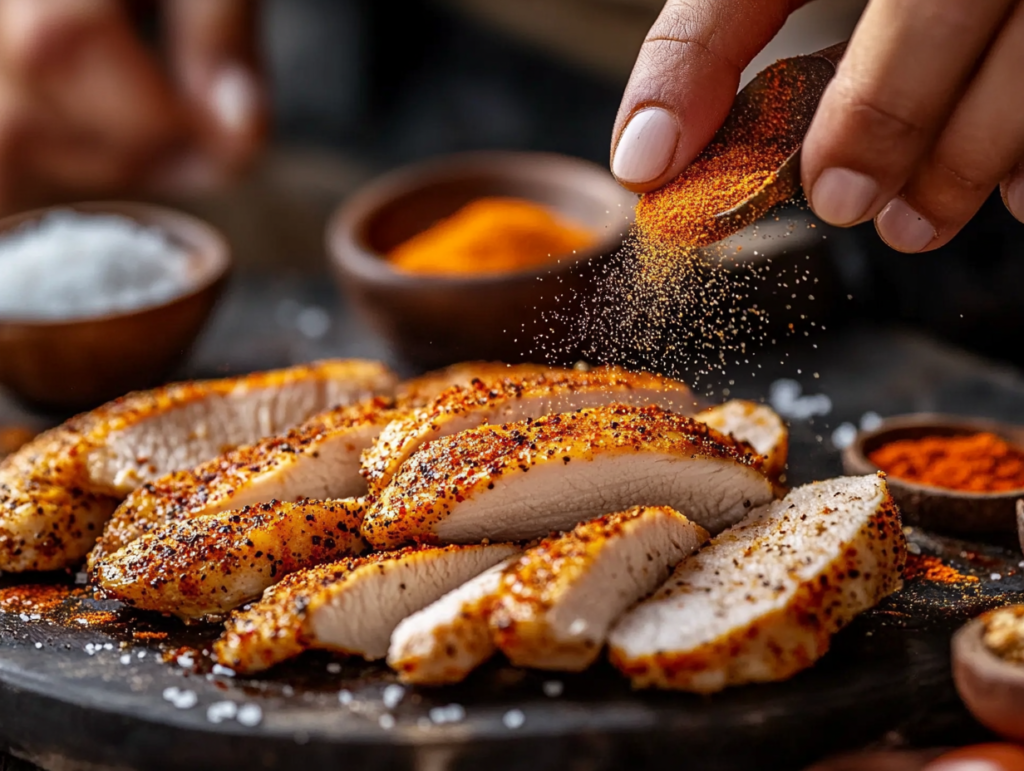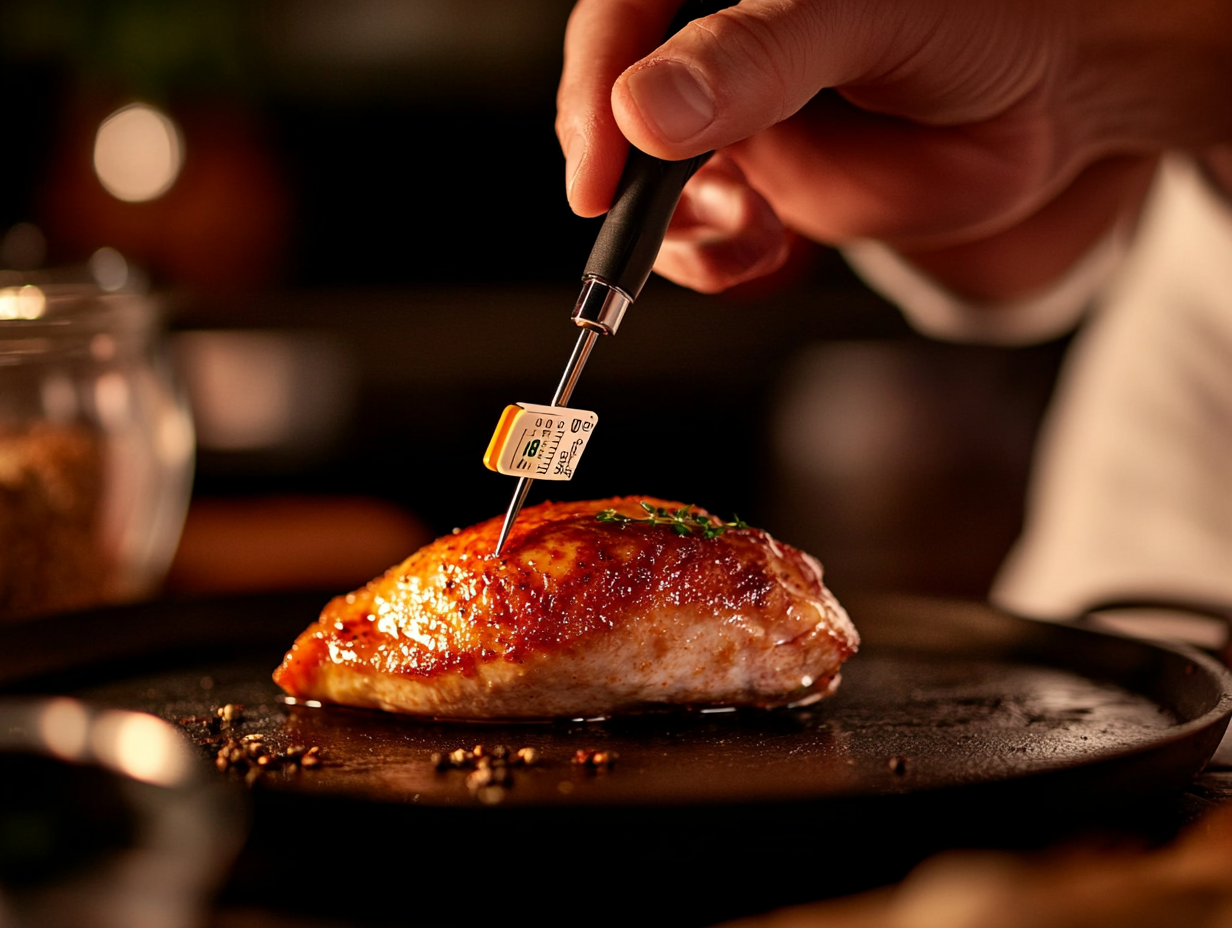Imagine you’re in your kitchen, and the smell of chicken fills the air. You’ve prepared and seasoned everything, ready to impress your family. But, you’re unsure: how to know when thin-sliced chicken breast is done? This mix of excitement and worry is common.
Knowing when chicken is done is key to avoiding foodborne illness. Don’t worry, we’ve got you covered. This guide will teach you chicken cooking tips to cook it perfectly every time.
Thin-sliced chicken breasts need to be cooked just right for safety and taste. In 12-15 minutes at 400°F, you can make it tender and juicy. Follow these five tips to cook it to perfection, ensuring a delicious and memorable meal.
Table of Contents
Understanding the Importance of Chicken Doneness
Cooking chicken breast right is key for great taste and texture. Chicken is a favorite protein in the U.S. It’s important to cook it well. This keeps it juicy and flavorful. Also, knowing the dangers of undercooked chicken is vital for food safety.
Significance of Cooking Chicken Properly
Well-cooked chicken makes any dish better and safer to eat. The USDA says chicken should be cooked to 165°F (74°C) to kill harmful bacteria. This ensures the chicken is safe to eat, reducing the risk of getting sick.
Health Risks of Undercooked Chicken
Undercooked chicken can be very dangerous. It can cause food poisoning from bacteria like salmonella. These bacteria grow in chicken that’s not cooked enough. So, it’s important to cook chicken properly for both taste and health.
How to Know When Thin-Sliced Chicken Breast is Done
Figuring out when the thin-sliced chicken breast is cooked needs careful watching. You should check both the internal temperature and look for visual signs. The chicken is safe and tasty when it reaches 165°F (75°C).
Checking Internal Temperature: A Key Factor
The best way to check if chicken is cooked is with a meat thermometer. Put it into the thickest part of the breast. Aim for 165°F to kill off harmful bacteria, ensuring the chicken is safe to eat.
Visual Cues to Look For During Cooking
Also, look for visual signs that the chicken is done. Watch as the meat turns from pink to firm white. If the juices are clear, not red or pink, it’s cooked right. These tips will make cooking chicken easy and worry-free.
Choosing the Right Cooking Method
Choosing the right cooking method is key for great flavor and texture in thin-sliced chicken breast. Different methods can greatly affect the final dish. Here are some top methods, like baking and grilling, to help you cook chicken perfectly every time.
Baking Thin-Sliced Chicken Breasts in the Oven
Baking is a top choice for cooking chicken breast, and thin slices are no exception. It lets you control the temperature for even cooking. Preheat your oven to 400°F for the best results.
Thin-sliced chicken breasts usually need 10-13 minutes in the oven. Make sure the chicken reaches a safe 165°F. For extra flavor, marinate the chicken for at least 30 minutes before baking.
Grilling Tips for Perfectly Cooked Chicken
Grilling is also a great way to cook thin-sliced chicken. It adds a smoky taste and a nice char. Preheat your grill and cook the chicken for about 4-5 minutes on each side, depending on its thickness.
To keep the chicken juicy, don’t press down on it while grilling. Always check the temperature to ensure it reaches 165°F for safety.
| Cooking Method | Temperature | Time (Approx.) | Internal Temperature |
|---|---|---|---|
| Baking | 400°F | 10-13 minutes | 165°F |
| Grilling | Medium-high | 4-5 minutes per side | 165°F |
Using these cooking methods will make your cooking experience better. Whether you choose baking or grilling, remember to manage the temperature well. This is the secret to juicy, flavorful chicken.
Essential Cooking Tools for Checking Chicken Doneness
Using the right tools is key to cooking chicken perfectly. They help you avoid undercooked or overcooked chicken. This ensures your meal is delicious. Here are some must-have tools and tips for cooking chicken well.
Using a Meat Thermometer Effectively
A meat thermometer is a must-have for checking chicken doneness. It gives you exact internal temperature readings. For perfectly cooked chicken, aim for an internal temperature of 165 degrees Fahrenheit.
Insert the thermometer into the thickest part of the meat, but avoid bones. This way, you get an accurate reading. With this tool, you can cook chicken to perfection without guessing.
Other Tools That Can Assist You
There are other kitchen tools that can help ensure your chicken is cooked just right:
- Timers: Use timers to keep track of cooking times. For example, grilled chicken breast usually cooks for 6-9 minutes per side.
- Visual Cue Checklists: Knowing visual signs can also help. Look for clear juices and even meat color.
- Instant-Read Thermometer: This tool lets you check temperatures quickly without waiting for the meat to rest.

Adding these tools to your cooking routine will help you check chicken doneness accurately. This leads to consistently delicious chicken dishes.
5 Foolproof Tips for Ensuring Chicken Breast Doneness
To get chicken breast just right, you need to pay close attention and use smart techniques. These tips will make your chicken breast cooking better and more enjoyable every time.
Tip 1: Pound for Even Thickness
Making chicken breast the same thickness is key for even cooking. Try to get it between ½ to ¾ inches thick. This ensures it cooks well all over, avoiding dry edges and raw centers. Use a meat mallet to make 10-15 holes in each breast, making it tenderer.
Tip 2: Proper Seasoning Affects Cooking
Seasoning your chicken right is important for flavor and cooking. Use about ½ teaspoon on each side. Good seasoning brings out the chicken’s natural taste, making your meal better.
Tip 3: Rest the Chicken After Cooking
Let your chicken rest for 5 minutes after cooking. This lets juices spread evenly, making each bite juicy and tasty. It’s a must for keeping the meat moist.
Tip 4: Monitor Cooking Time Closely
Cooking chicken breast in a 450°F oven takes 18-22 minutes. On the stovetop, cook each side for 5-7 minutes on medium-high. Watching the time closely helps prevent overcooking and keeps the chicken juicy.
Tip 5: Rely on Visual and Textural Clues
Check if the chicken is done by looking and feeling it. It should be juicy and firm. The internal temperature must be at least 160°F for safety. An instant-read thermometer is best for checking the chicken’s doneness accurately.
Understanding Internal Temperature for Chicken
Knowing the exact internal temperature of chicken is key for its safety and taste. The USDA says chicken must reach 165°F (74°C) to kill harmful bacteria like Salmonella. This ensures chicken breasts are both juicy and safe to eat.
Optimal Temperature for Cooked Chicken Breasts
The target temperature of 165°F is for all chicken parts. For white meat, like chicken breasts, it’s vital to keep this temperature for 30 seconds. This balance ensures safety and juiciness.
Cooking chicken breasts to 150°F (65.6°C) for three minutes can also work well. This method keeps the meat moist without risking safety. Remember, pulling the chicken at 162°F helps with carry-over cooking, making it even more tender.
Different Cooking Styles and Their Temperatures
The cooking method greatly affects the chicken’s internal temperature and doneness. Here are some common styles and their recommended temperatures:
| Cooking Method | Recommended Temperature | Notes |
|---|---|---|
| Grilling | 165°F (74°C) | Quick cooking; requires monitoring |
| Baking | 165°F (74°C) | Ideal for even cooking; preheat oven to 500°F, then reduce |
| Sous Vide | 165°F (74°C) | Maintains perfect temperature; great for juicy results |
| Roasting | 165°F (74°C) | For dark meat, aim for 175°F (76.7°C) to 180°F (82.2°C) |
Using different cooking methods lets you achieve the perfect chicken breast doneness. This ensures safety and a delightful meal.

Common Mistakes to Avoid When Cooking Chicken Breast
Cooking chicken breast can lead to common mistakes. These errors can affect the taste and texture of your dish. Knowing the right techniques is key to avoiding dry, tasteless meat. Here are two big mistakes to steer clear of.
Overcooking: The Enemy of Juiciness
Many home cooks overcook chicken breast, losing its moisture and tenderness. The lean nature of boneless, skinless chicken makes it dry easily. To keep it juicy, cook it to an internal temperature of 165°F. Remove it from heat when it hits 145°F to 155°F to let it rest and cook a bit more.
Using a meat thermometer helps avoid overcooking.
Underseasoning: Enhancing Flavor
Underseasoning can make chicken taste bland. Seasoning well can enhance the meat’s natural flavors. Marinating is a great way to add flavor, aiming for at least 4 hours or overnight. Dry brining for 20 minutes to 24 hours also helps keep the meat moist and flavorful.
| Error Type | Description | Recommended Solution |
|---|---|---|
| Overcooking | Results in dry meat due to excessive heat exposure. | Check internal temperature with a thermometer and remove chicken from heat early. |
| Underseasoning | Lack of flavor makes chicken dull and unappealing. | Use marinades or brining to enhance taste prior to cooking. |
Best Way to Cook Chicken Breast
Thin-slicing is a top choice for cooking chicken breast. It cooks quickly and evenly. This ensures the meat reaches 160-165°F without drying out.
A thickness of 1/2 inch or less makes it easier to achieve a juicy texture.

Why Thin-Slicing is Beneficial
Thin-slicing chicken speeds up cooking and boosts flavor. It lets the chicken soak up marinades better. A simple marinade of lemon juice, garlic powder, onion powder, and paprika adds great taste and aroma.
Flavor Enhancements Through Marinades
Marinades are key when cooking thin-sliced chicken. Aim for at least 15 minutes of marinating, but overnight is best. Use olive oil and spices to make the chicken taste amazing.
Marinades not only add flavor but also keep the chicken moist. So, when cooking chicken breast, thin-slicing and marinating are the best ways. You’ll get juicy, flavorful chicken every time.
How to Tell if Chicken is Cooked Beyond Doneness
Knowing when chicken is overcooked is key for keeping it tasty and tender. Overcooked chicken can become dry and tough. Spotting the signs of overcooking helps keep your meals tasty and enjoyable.
Checking for Juiciness and Texture
Look for signs of juiciness and texture when checking your chicken. A good chicken breast should be soft and moist. If it’s too dry or hard to cut, it’s overcooked.
The internal temperature should stay below boiling to keep it moist. Poached chicken should be around 155°F for the best taste.
What to Do if Chicken is Overcooked
If your chicken is overcooked, there are ways to fix it. Shredding the meat can add moisture back in. It’s better in soups, salads, or wraps, where other flavors can hide the dryness.
Always watch cooking times closely. This way, you avoid overcooking and keep the chicken at 165°F or below.
Conclusion
Knowing when thin-sliced chicken breast is done is key to great taste and texture. You can check by looking at the color and feeling its firmness. It’s also important to make sure it reaches 165°F (74°C) inside to keep it safe.
Using tips like pounding the chicken to even thickness helps a lot. Also, watching how long it cooks is important. This way, you can make sure your chicken is always perfect, no matter how you cook it.
Now, you’re all set to cook amazing chicken in your kitchen. With the right tips, you’ll make meals that everyone will love. Start cooking thin-sliced chicken breast and enjoy the delicious results!
FAQ
How do I know when thin-sliced chicken breast is done cooking?
To check if thin-sliced chicken breast is cooked, use a meat thermometer. It should read at least 165°F (75°C). You can also look for color changes and clear juices.
What are some common methods for cooking chicken breast?
Baking and grilling are popular ways to cook chicken breast. Baking at 400°F cooks it evenly. Grilling adds a charred taste. Always check the internal temperature.
What are the risks of undercooked chicken?
Undercooked chicken can cause serious health problems. Bacteria like salmonella and campylobacter can lead to infections. Cooking it to the right temperature is key to safety.
Why should I pound chicken before cooking?
Pounding chicken makes it even in thickness. This ensures it cooks evenly. It also makes the chicken tender and improves its texture.
How can I prevent chicken from being dry?
To keep chicken moist, don’t overcook it. Use a meat thermometer to check the temperature. Let the chicken rest briefly before slicing to keep it juicy.
Should I marinate thin-sliced chicken? What are the benefits?
Yes, marinating chicken adds flavor and tenderness. Marinades with lemon juice, vinegar, herbs, and spices enhance taste and texture.
What are good visual indicators that chicken is cooked?
Look for color changes from pink to white and clear juices. The chicken should feel firm but not hard.
What should I do if I overcook my chicken?
If chicken is overcooked, shred it. Use it in soups, salads, or tacos. This hides the dryness and adds flavor.
What tools should I use to check chicken doneness?
A meat thermometer is the best tool for checking chicken. Timers and visual cues are also helpful.
Are there different cooking temperatures for different styles of chicken cooking?
Yes, while 165°F (75°C) is standard, grilling or frying might need adjustments. Cooking time changes with heat intensity and style.
Follow us on Facebook: https://www.facebook.com/AnyTimesRecipes/

